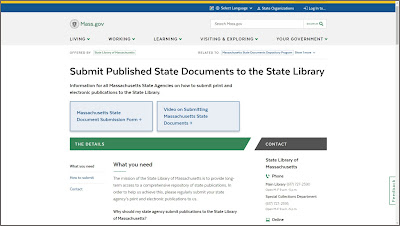One of the first things I learned on the project is that every collection is different, from the size of the collection to the type of records found within. The papers reflect each legislator’s unique districts, their areas of legislative focus, and their relationship with their constituents. So far, I have processed the collections of Representative Carlo Basile, Representative Frank Smizik, Representative George Peterson, and Senator Richard Ross. These collections are now open to researchers in the State Library’s Special Collections Department, in Room 55 of the State House.
Today, I want to tell you about one other collection that I have processed, the Thomas P. Kennedy Papers. Thomas Patrick Kennedy was a long-time legislator and familiar face around the State House. Born in Brockton, Massachusetts, he was the youngest child of Robert A. Kennedy, Jr. and Mary Louise Cruise Kennedy.
 |
| Thomas Patrick Kennedy, 3 Months, With Love from Your Father, Bob |
After his high school graduation, Kennedy entered the Our Lady of Hope Seminary in Newburgh, New York. His intention was to become a priest, but an accident at the seminary in 1970 left him a quadriplegic. After some years of recovery and reflection, Kennedy redirected his ambitions to public office, where he could satisfy his need to be useful to his community. His first government job was as the Brockton City Ombudsman, a role he held for several years. He followed that by becoming the Ward 2 member of the Brockton City Council.
 |
| Thomas Kennedy, Brockton Ward 2 City Council, circa 1983 |
 |
| Certificate declaring
Kennedy had won his bid for Ward 2 seat on the Brockton City Council. |
 |
| Kennedy and his mother Mary Cruise watching the City Council election returns, 1978. |
Kennedy soon cast his goals higher and ran for state office, representing his district for over thirty years, first as a Massachusetts State Representative and then as a State Senator. Sadly, Kennedy passed away in June of 2015 at the age of 63, due to complications from pneumonia.
 |
| State Representative photo shoot, 2004 |
The Kennedy collection, which was donated to the Special Collections Department by his family, is an interesting mix of professional and personal records. Some things that you will learn about Kennedy by studying his papers:
- You will see his long career documented, perhaps by his mother, in scrapbooks filled with newspaper clippings.
 |
| One of two oversize scrapbooks found in the Kennedy collection. |
- His career began long before the internet, so in the correspondence you will find handwritten letters, notes, greeting cards, and postcards. If you have some time to read the letters and thank- you notes, you will discover that Kennedy was well-liked by all who knew him. His correspondence documents his many acts of kindness, help, and advice to his family, friends and constituents. Here you will also discover that his family and friends called him “Monty” - a nickname from his nephew, A.J. Kennedy, who as a young boy couldn’t pronounce the name Tommy, but could say Monty.
- Kennedy had planned to be a priest. Although that did not come to pass, you will find that he remained a man of deep faith. He considered his Honorary O.M.I (Oblates of Mary Immaculate) in 1978 to be one of his greatest honors.
 |
| Invitation to Kennedy’s Honorary OMI celebration, 1978 |
- Kennedy was very interested in his Irish roots and surrounded himself with all things Irish. He had great love and pride in his family, especially his mother, who lived to be 101 years old. He invested time in genealogical research of his family in Brockton, Ireland, and Nova Scotia. And his signature color was green, which you will find in his campaign materials.
 |
| Brochure from Kennedy’s 1992 State Rep campaign |
 |
| Bumper sticker from Kennedy’s 2008 State Senate campaign |
One of the things I love about being an archivist is the ability to preserve the voices of the past for the benefit of future researchers. In working on Kennedy’s papers, it became clear that I was not only preserving a record of his legislative career, but I was also preserving a glimpse into his big-hearted personality, his enduring faith, and his pride in his family and hometown. I am glad that I had the opportunity to “meet” this remarkable Massachusetts legislator. The collection is now open to researchers at the Special Collections Department if you would like to learn more about him too.
 |
| Kennedy with his cousin, Sean Cruise, at the State House, 2006 |
Deanna Parsi
Special Collections Department





